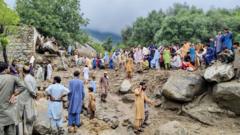How Did Flash Floods Claim Over 160 Lives in Pakistan?

Understanding the Impact of Monsoon Floods in Pakistan and Kashmir
The recent monsoon floods and landslides in Pakistan and Pakistan-administered Kashmir have led to a tragic loss of life, with at least 164 people reported dead in the last 24 hours alone. This catastrophic event highlights the vulnerability of these regions to extreme weather phenomena, exacerbated by climate change. The heavy rainfall has not only caused destruction but has also led to significant challenges in rescue operations, further complicating the situation for affected communities.
The Current Situation: A Closer Look at the Numbers
Among the devastating statistics, the mountainous region of Khyber Pakhtunkhwa has been particularly hard-hit, recording approximately 150 fatalities. This region is known for its rugged terrain, which is prone to landslides during heavy rainfall. In addition to the loss of life, at least 30 homes have been reported destroyed, leaving many families displaced and in desperate need of assistance.
Furthermore, a tragic incident occurred during rescue operations when a helicopter crashed due to poor weather conditions, resulting in the deaths of all five crew members on board. Such accidents underscore the dangers faced by those involved in rescue efforts during natural disasters.
Geographical Impact: Regions Affected by the Floods
Aside from Khyber Pakhtunkhwa, the floods have also claimed lives in Pakistan-administered Kashmir and the northern Gilgit-Baltistan region, where at least nine and five deaths have been reported, respectively. These areas are characterized by their mountainous landscapes, which can contribute to rapid runoff and the occurrence of landslides during intense rainfall.
Forecasts and Warnings: The Impending Threat
Government meteorologists have issued warnings of continued heavy rainfall, expected to last until August 21. The northwest region of Pakistan has been placed under a heavy rain alert, prompting authorities to declare several areas as disaster zones. The anticipation of further rainfall raises concerns about additional flooding and landslides, compounding the already dire situation.
Emergency Response and Challenges
The response to such natural disasters often faces numerous challenges. The chief minister of Khyber Pakhtunkhwa, Ali Amin Gadapur, has noted the difficulties posed by the weather, which led to the helicopter crash in Bajaur. Rescue operations are further complicated by the terrain and the volume of water, making it hard for rescue teams to reach those in need.
Images from the region depict crowds gathering around excavators working to clear mud and debris, while funeral prayers are held nearby for the victims. The emotional toll on the communities affected is immense, as families grieve the loss of their loved ones.
The Broader Context: Monsoon Rains and Climate Change
Monsoon rains play a critical role in the climate and agriculture of South Asia, delivering about three-quarters of the annual rainfall. However, the intensity and frequency of these rains have been increasing, leading to more severe floods and landslides. This year's monsoon season has already seen over 300 fatalities, with Punjab province experiencing a staggering 73% increase in rainfall compared to the previous year.
Scientists attribute these extreme weather events to climate change, which has been shown to create more erratic and intense weather patterns. As the planet continues to warm, regions like Pakistan and Kashmir may face an increasing frequency of devastating natural disasters.
Preparedness and Future Strategies
In light of the recurring nature of these disasters, it is essential for governments and communities to adopt proactive measures for disaster preparedness. Some strategies may include:
- Enhanced forecasting technologies: Investing in advanced meteorological tools can improve early warning systems and help communities prepare for impending disasters.
- Infrastructure improvements: Reinforcing buildings and roads to withstand severe weather can reduce the impact of floods and landslides.
- Community education: Raising awareness about disaster preparedness can empower individuals and families to take necessary precautions.
- Climate adaptation strategies: Implementing long-term strategies to mitigate the effects of climate change can help communities become more resilient to extreme weather events.
Conclusion: The Need for Urgent Action
The recent floods in Pakistan and Kashmir serve as a stark reminder of the devastating effects of climate change and the urgent need for effective disaster management strategies. As communities come together to support one another during this difficult time, it is crucial for policymakers to prioritize the implementation of adaptive measures to minimize future risks.
How can individuals contribute to disaster relief efforts in their communities and raise awareness about the impacts of climate change? Taking collective action can foster resilience and support recovery in the face of adversity.
FAQs
What causes monsoon floods in Pakistan?
Monsoon floods in Pakistan are primarily caused by intense rainfall during the monsoon season, often exacerbated by the region's topography, which is prone to landslides and runoff.
How can communities prepare for future floods?
Communities can prepare for future floods by investing in infrastructure improvements, enhancing early warning systems, and educating residents about disaster preparedness.
What role does climate change play in extreme weather events?
Climate change contributes to the increasing frequency and intensity of extreme weather events, including monsoon floods, by altering global weather patterns.
As we reflect on these tragic events, it is imperative to consider the broader implications of climate change and our role in addressing it. What steps can we take to foster a more sustainable future for vulnerable communities? #PakistanFloods #ClimateChange #DisasterPreparedness
Published: 2025-08-15 13:07:16 | Category: technology



